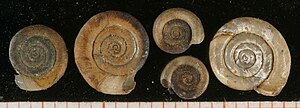Lipped pan snail
| Lipped pan snail | ||||||||||||
|---|---|---|---|---|---|---|---|---|---|---|---|---|

Lipped pan snail |
||||||||||||
| Systematics | ||||||||||||
|
||||||||||||
| Scientific name | ||||||||||||
| Anisus spirorbis | ||||||||||||
| ( Linnaeus , 1758) |
The lipped pan snail ( Anisus spirorbis ) is a water lung snail (Basommatophora) from the family of pan snails (Planorbidae).
features
The case is 1 to 1.5 mm high and measures 4 to 5.5 mm in diameter. It is disc-shaped and has about 4.5 whorls. The mouth is inclined to the coil axis. The whorls increase relatively quickly (compared to other aniseed species). They have an edge on the underside. The surface is covered by fine growth strips, the color of the housing is horn-colored. The body of the animal is gray-black and becomes a little lighter towards the edge of the sole.
Reproduction
The animals become sexually mature after 3 to 6 months. After mating, they repeatedly lay small spawning capsules up to about 2 mm in diameter with 3 to 7 eggs. A first spawning period is in April / May and probably a second in summer. The development in the egg is very rapid, depending on the water temperature, the animals hatch after 7 days. The housings of the hatchlings measure 0.5 to 0.6 mm in diameter. The animals hatched in spring overwinter twice and usually die after the second (or third) spawning in the spring of the following year; d. that is, they usually live to be around 2 years old.
Way of life, occurrence and distribution
The species lives in small ponds, swamps and unstable ponds. It also tolerates slightly salty water (up to approx. 5 per thousand). It is therefore also found in the Baltic Sea. Little is known about diet. Presumably they eat green algae as well as wilted and possibly also fresh plants (observed on Callitriche palustris (swamp water star)). They are very persistent in preventing their waters from drying out. The animals fall into a dry rigidity, the housing being closed with a diaphragm. They also endure deep frosts in winter. With the exception of the western Mediterranean area, it occurs all over Europe. In the east the distribution area extends to Siberia, in the southeast to eastern Anatolia.
Similar species
The species differs from the other Anisus species by the faster increasing whorls, which are much higher. In addition, she has only a few interactions.
Danger
The species is on the "Red Lists" of endangered species in various German federal states (e.g. Saxony-Anhalt, Mecklenburg-Western Pomerania, Bavaria, Baden-Württemberg). It is critically endangered or already threatened with extinction. The species is also on the "Red Lists" of endangered species in Switzerland. There it is classified as "vulnerable" (= endangered).
Systematics
The genus Anisus is divided into two sub-genera by some of the authors: Anisus (Anisus) Studer, 1820 and Anisus (Disculifer) C. Boettger, 1944. In this sub-genus, Anisus spirorbis is placed in the nominated sub-genus Anisus .
literature
- Rosina Fechter / Gerhard Falkner: Mollusks . Mosaik-Verlag, Munich 1990, ISBN 3-570-03414-3 , ( Steinbach's natural guide 10).
- Ewald Frömming: Biology of the Central European freshwater snails. 313 pp., Duncker & Humblot, Berlin 1956.
- Peter Glöer: The animal world of Germany. Mollusca I Freshwater gastropods of Northern and Central Europe Key to identification, way of life, distribution. 2. rework. Ed., 327 D., ConchBooks, Hackenheim 2002 ISBN 3-925919-60-0